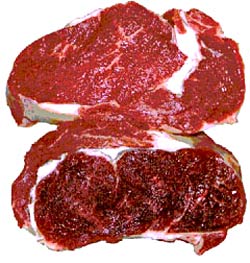As I've read, I've come across many new terms and ideas that are integral to a real understanding of meat. One term that I've encountered a couple times now is something called a "dark-cutter." When I first read it, my mind immediately associated it as sounding like the name of a teenage goth-band playing angsty songs based on high school lit poetry. Even though the term was treated with minimal discussion in the sources I found it, it stayed with me in the back of my mind.
Until last week, when it was spat back to the surface.
I was at my local Safeway (a small, cramped, understocked one whose only saving graces are the friendly staff and the fact that its open 24 hours) and found myself slowly cruising down the meat cases, idly side-stepping Asian grandmothers and harried hipsters. Of course, I am a big supporter of the local-humane-grass-fed movement and I have been getting most of my meat from my Marin Sun Farms meat-CSA and some of the local butcheries, but I really cannot pass up the chance to ogle at racks and racks of raw, red beef (it's like paleo-porn). (Also, to be entirely honest, I continue to pick up flenken-cut shortribs at Safeway because I don't like the ones from Marin Sun Farms and I have yet to ask the butcher shops if I can order any).
I was at my local Safeway (a small, cramped, understocked one whose only saving graces are the friendly staff and the fact that its open 24 hours) and found myself slowly cruising down the meat cases, idly side-stepping Asian grandmothers and harried hipsters. Of course, I am a big supporter of the local-humane-grass-fed movement and I have been getting most of my meat from my Marin Sun Farms meat-CSA and some of the local butcheries, but I really cannot pass up the chance to ogle at racks and racks of raw, red beef (it's like paleo-porn). (Also, to be entirely honest, I continue to pick up flenken-cut shortribs at Safeway because I don't like the ones from Marin Sun Farms and I have yet to ask the butcher shops if I can order any).
In any event, after I passed the pre-wrapped cuts, I made a quick pass along the meagerly-stocked glass case, gaining speed to continue shopping, when I suddenly stopped. At the end of the case was a line of rib-eye steaks, about six in all, three of the cuts looked completely different from the others. While half of the steaks were the expected bright red, with maybe some touches of grey from aging, the top three were dark, almost purple in color, with a strange, almost-translucent quality. My mind brought back that term from where it had been shelved, along with the chords of a poorly-tuned electric guitar: dark cutter.
I was taken aback, because dark-cutter meat was something the books I had read (written by butchers) spoke of dark-cut meat as something bad and not sold. So then why were these cuts out? Maybe I was mistaken and these weren't examples of this mysterious angsty beef. I got to wondering further about the term, whether dark cutting identifies beef that is bad to eat in some way, or just of lower quality.
It stayed on my mind as I finished shopping and left the store, and I looked it up as soon as I got home. The first page that came up was a page from the state agriculture department of New South Wales, Australia. Although the source was a little unexpected, it answered all my questions.
The picture on that site, reproduced here at the right, verified that what I had seen was in fact dark-cut beef. A normal cut of red meat will "bloom" bright red when exposed to the oxygen in the air. A dark-cut keeps a deep, almost purplish shade. It occurs because the muscle of the animal had low glycogen stores when the animal was slaughtered. Glycogen is a molecule that provides the muscles with energy. The body normally stores glycogen in the muscles and liver in order for it to be available immediately when the body needs it. A dark-cutting animal has had its glycogen stores drained before slaughter.
The question then, of course, is why. It seems the most common cause is stress on the animal before slaughter. Both the Australian site and Texas A&M say that the most common causes are long, stressful transports and rough handling. It's no wonder then that the meat books I've been reading--which advocate humanely-raised animals from local sources--eschew such meat. But the Australian site points out that, ethical reasons aside, there may be an inherent problem in the quality of the meat, saying that the pH remains too high and the meat turns out very dry when cooked.
But Safeway put it out for sale. Given the general public's disassociation from understanding our food and where it comes from, it's quite likely that those cuts sold to customers who didn't know what it meant. Hell, it's highly likely that the "butchers" working the meat counter there didn't even know what it meant.
But just in case I needed another reason to be wary of mass-produced grocery store meats, I apparently found one.

No comments:
Post a Comment